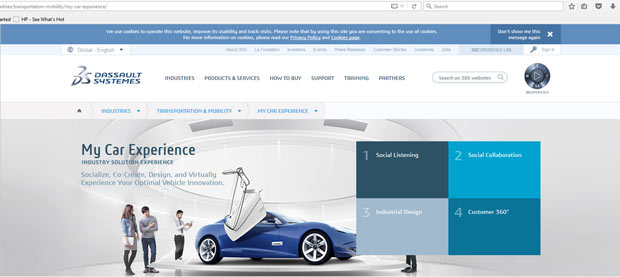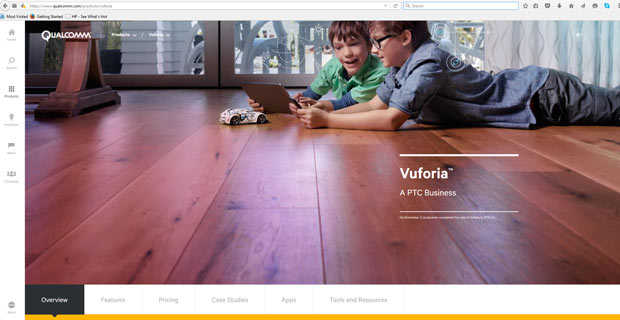
Dassault Systèmes’ auto industry solution, the My Car Experience platform, includes social listening, to “compile, analyze and share industry trends and customer perspectives.” Image courtesy of Dassault Systèmes.
Latest News
January 1, 2016
 Dassault Systèmes’ auto industry solution, the My Car Experience platform, includes social listening, to “compile, analyze and share industry trends and customer perspectives.” Image courtesy of Dassault Systèmes.
Dassault Systèmes’ auto industry solution, the My Car Experience platform, includes social listening, to “compile, analyze and share industry trends and customer perspectives.” Image courtesy of Dassault Systèmes.About a decade ago, product lifecycle management (PLM) was the manufacturing industry’s ultimate business transformation goal. The approach, which called for data consolidation and process re-engineering, spawned a new industry of software and services. But these days, the PLM market leaders are setting their sights on something else.
In analyst CIMdata’s annual PLM market reports, three names together consistently account for the biggest segment of the revenue pie: Dassault Systèmes, PTC and Siemens PLM Software. However, the industry is growing its focus on trends beyond PLM. In the last five years, PTC executed a rapid succession of acquisitions (MKS in 2011, ThingWorx in 2013, Axeda in 2014, ColdLight and Vuforia in 2015) aimed at the design and development of smart, connect devices.
Dassault Systèmes went through a vigorous rebranding campaign, billing itself as the 3DEXPERIENCE company. Describing its offerings, Dassault Systèmes writes, “[The] 3DEXPERIENCE platform allows simulation of IoT (Internet of Things) devices in a virtual environment to discover every scenario before we use the products in real life.”
As a division of Siemens, Siemens PLM Software remains focused on manufacturing-related technologies. Even so, in a nod to the growing importance of embedded software in industrial IoT, Siemens PLM recently acquired Polarion, an application lifecycle management (ALM) vendor. It also expanded its reach into test management by acquiring LMS International NV in 2012, and into enterprise manufacturing execution systems (MES) software by acquiring Camstar in 2014, which included the company’s Omneo Big Data analytics platform.
A “system” is a construct or collection of different elements that together produce results not obtainable by the elements alone. The elements, or parts, can include people, hardware, software, facilities, policies and documents; that is, all things required to produce system-level results.—NASA Systems Engineering Handbook, SP-2007-6105, Rev1
In the words of Monica Menghini, Dassault Systèmes’ executive VP and chief strategy officer: “The consumer’s journey is the new product” (3DEXPERIENCE Forum, San Francisco, November 2015). If we accept the premise that the product is not just the tangible object sold to the consumer but the overall consumer experience, the so-called system expands considerably. It would encompass online product configurators, predictive analytics based on field data, apps and post-sales services. Simulation would include not only the product’s electromechanical behaviors but also the software-triggered operations and the consumer’s interaction. The system demanded by the IoT may be far broader than what the current system engineering and PLM tools tackle.
Designing the Experience
A car as a product is an electromechanical system that runs on fuel. On the other hand, a car as a driving experience (to borrow BMW’s words “the ultimate driving experience”) demands much more. The in-car multimedia console, Wi-Fi connectivity, automatic firmware updates, onboard navigation, voice response, semi-autonomous braking and parking, even the online customization interface with instant previews and the post-sales services are all part of the consumer’s journey—an example of the type of “experiences” that Dassault Systèmes believes its customers will package and sell.
The key to designing the experience is systems engineering—a strategy that demands collaborative and simultaneous development of control software, hardware and anything else in-between. It even includes listening to the consumer chatter—positive and negative—about similar classes of products or competitor products. Dassault Systèmes’ My Car Experience, a set of offerings that cater to the auto industry, includes Social Listening, described as a way to “collect and analyze pertinent customer perspectives and requirements to align and enhance your vehicle development.”
Virtual Avatars in AR Apps
At its LiveWorx Conference in May 2015, PTC put on a show to demonstrate the concept of a digital twin: A virtual replica that mimics and records the operations of a real product in the field. Using a mountain bike from Santa Cruz Bicycles equipped with sensors, Mike Campbell, PTC’s executive vice president of Digital Twin, showed how a digital 3D model of the bike could faithfully duplicate the operations of the real bike in real-time. The experiment was made possible by streaming sensor data from the physical bike to the ThingWorx dashboard, which drove the 3D CAD model. Therefore, the digital bike’s wheel speed, pedal action, suspension operations and steering angles accurately reflected those of the real bike.
 PTC’s acquisition of Vuforia gives the company a way to bridge the digital and physical worlds in augmented reality (AR) apps. Image courtesy of PTC.
PTC’s acquisition of Vuforia gives the company a way to bridge the digital and physical worlds in augmented reality (AR) apps. Image courtesy of PTC.In the demonstration, PTC presenters used an AR (augmented reality) app on an iPad to display the sensor data collected from the bike. But the company’s recent acquisition of Vuforia from Qualcomm suggests that the interaction with digital twins could become much more interactive and sophisticated.
Systems on the Screen
Some in the industry think that specific industries already have a head start in system-level thinking. “Aircraft are complex systems, an integration of code, machine, and platform that’s very mature,” says Michel Tellier, VP of Aerospace & Defense at Dassault Systèmes. “Before, software development, structural design, and system design took place in their own toolsets, within their own processes—almost a parallel development of separate systems. They worked somewhat autonomously, then came together much later in the development cycle. But that’s no longer a viable approach.”
One of the hurdles to a systems-level design approach is visualization. Displaying a complex system like an aircraft with all its internal components and layers of engineering data requires robust hardware and graphics acceleration. The demand is much greater for simulating such a system as a detailed 3D assembly model.
“It’s not so much loading the data, but about not taking a week to load,” said Tellier. “Thirty years ago, it took dedicated hardware, dedicated software, machines and networks to make it possible. Now, we can do it on the desktop—at least for structures.” The 3DEXPERIENCE platform, Tellier said, is designed specifically to allow engineers to work with large-scale digital mock-ups of systems—“functional mock-ups” as he calls them.
Big Data Mining
The vast volume of data collected by IoT devices is both a blessing and a curse. Enterprising businesses could use the data to predict imminent failures and proactively offer replacement parts or maintenance services. But to do that, they would need a way to extract useful patterns out of the data.
With its acquisition of ColdLight, PTC now has a solution for machine learning and predictive analytics. Explaining its strategy, PTC writes: “When combined with PTC’s ThingWorx IoT platform, ColdLight’s Neuron will automate the analysis of data from things to address a range of important challenges. These challenges include detecting failure patterns from data, modeling correlations, predicting failures, prescribing remedies and prioritizing recommendations against cost constraints.”
“Sensor data by itself creates value, but that value is magnified dramatically when companies use predictive analytics to process that data into many forms of actionable knowledge that can transform the way they do business, ” says Jim Heppelmann, president and CEO of PTC.
There are also opportunities in Big Data. “People can then work with not only data from engineering knowledge but also with usage data collected from the field,” says Olivier Sappin, VP of Transportation & Mobility Industry at Dassault Systèmes.
Dassault Systèmes owns the enterprise search engine EXALEAD, which it acquired in 2010. EXALEAD has been integrated into its PLM offerings to power search and sort functions. IoT presents another chance to deploy it.
The New Game
The art and science of product development in the past revolved around shapes and electromechanical operations, designed and tested in geometry modeling and simulation software. The process—a mix of synchronous and asynchronous collaboration—is managed in PLM. But embedded software, apps and connectivity add new layers of complexity.
Not all of the IoT features—or experiences—can be conceived and simulated in the current generation of system engineering and PLM software. With acquisitions, new products and new strategies, some leading PLM vendors are lining up the chess pieces to do battle for IoT market share. So far, they have solutions that tackle different aspects of IoT product development. But their aspiration is clearly to become a one-stop shop with an IoT system engineering solution.
Editor’s Note: Some parts of this article originally appeared in DE Senior Editor Kenneth Wong’s Virtual Desktop blog post on the Dassault Systèmes 3DEXPERIENCE Forum. Read it at Virtual Desktop.
More Info
Subscribe to our FREE magazine, FREE email newsletters or both!
Latest News
About the Author
Kenneth Wong is Digital Engineering’s resident blogger and senior editor. Email him at [email protected] or share your thoughts on this article at digitaleng.news/facebook.
Follow DE





